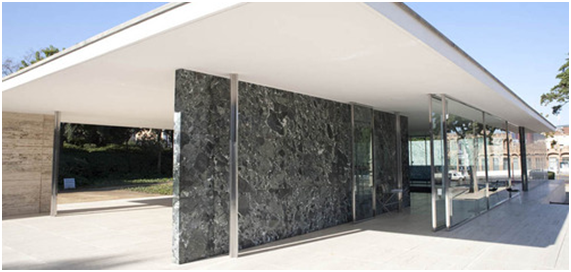Mies van der Rohe : an architectural landmark in Barcelona

By Jacqueline Mainguy
It was at the 1929 International Exhibition in Barcelona that the architect Ludwig Mies van der Rohe first exhibited his avant-garde talent. The German Pavilion was nestled in a wooded corner on the hill of Montjuic Park: Mies van der Rohe didn’t want to be crowded in by the many other international exhibitors. He was representing Germany, and welcomed the Spanish monarch Alfonso XIII as well as German officials. Through his building, Mies van der Rohe presented all the essential aspects of his architectural philosophy: perfect symmetry, space, clarity, simplicity and minimalism.
The Pavilion, which sat on a long plinth, gave the architect the opportunity to experiment with two principles. First, its open plan uses very few walls. Rather than being load-bearing, those that remain serve simply as lightweight partitions. Secondly, the horizontal line of the flat roof expresses the fluidity of early modernism, and echoes the form of a reflecting pool.
The internal spaces were articulated from inside to out in a dynamic fashion, communicating all at once a certain symmetry, albeit unbalanced. His taste for ancient Greek and Roman buildings influenced his choice of materials, including luxurious, exotic marbles, green and gold, onyx from the Atlas Mountains and travertine, all of which added a surprising twist to his modernism. The almost transparent interior glass walls, fine steel supporting columns, and a single wall in green marble gave the whole structure a lightness, setting it apart from the other pavilions.

Following the exhibition, the building was demolished in 1930. Finally, in 1989 it was decided to rebuild the 1929 structure, as an emblem of the architect’s influence on contemporary design and modern architecture. Once complete, the pavilion became the centerpiece of a foundation open to the public.
Mies van der Rohe, who immigrated permanently to Chicago to escape Nazism, continued to pursue and to influence modern architecture throughout his career. His work inspired the great glass-faced buildings such as today’s skyscrapers.
Neat, rectangular lines and high-quality materials such as steel, reinforced glass and wood form a pure and simple shape. Such are the characteristics of work by the German architect, born in Aix-la-Chapelle in the late 19th century, and who died in the United States in 1969.
Jacqueline Mainguy / English translation courtesy of Jeanette Weston